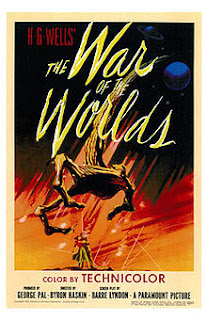The War of the Worlds
Released in 1953, the first theatrical film based on H. G.
Wells novel, The War of the Worlds,
became an instant hit. The movie was directed by Byron Haskin, produced by
George Pal and Barre Lyndon provided the script. When aliens visit Earth, they
do not come in peace. They begin by shooting heat-rays that vaporized the humans
immediately. Dr. Forrester is witness to one of the first alien attacks, and is
later able to obtain a blood sample from an alien he kills, along with a piece
of their technology. The military soon drops an atomic bomb on the aliens, but
they have no effect of the machines, leaving a grim outlook. Originally, the
last one-third of the film was supposed to be shot in 3D, but the budget did
not allow for it. They wanted to avoid the cliché look of UFOs in the 50s, and
came up with the design for the ships that resembled a manta ray. The iconic
electronic eye that was attached to the ships has been emulated many times in
films since. The movie was met with positive reviews and was a box office
success grossing $2 million. The War of
the Worlds won an Academy Award for Special Effects. In 2011, the movie was
selected for preservation in the National Film Registry, and is considered one
of the best science fiction movies of its time, as well as becoming a
classic.
When A Stranger Calls
Producer Steve Feke and director Fred Walton penned the
screenplay for When A Stranger Calls with inspiration from a folk legend titled
“The Babysitter and the Man Upstairs”. It is the tale of a young woman, Jill
Johnson, portrayed by Carol Kane, who is babysitting a pair of children. She
begins receiving distressing phone calls from a mystery man and when she alerts
the police, they are finally able to trace the phone call back to inside the
house. The police arrive and Jill is saved, however, the children were murdered
upstairs as they slept. The film then goes forward seven years, showing that
the murderer has escaped from an institution. Officer John Clifford, played by
Charles Durning, had worked the case with Jill before, and the dead children’s
father hires the now private investigator Clifford to track down the murderer. The
murderer finds Jill who is now married with her own children and stalks her. Clifford
must stop him before he kills Jill. The movie had a budget of $740,000 and
grossed $21 million in the theatres when
it was released in 1979.
White Zombie
Made in 1932, White
Zombie was the first film to feature zombies. Bela Lugosi starred in this
film following the successful 1931 movie, Dracula.
Set in Haiti, the story follows Madeleine and Neil, who are to be married.
Throw in an evil voodoo priest, Murder Legendre (Lugosi) and Charles Beaumont,
who wants Madeleine for himself, and you have some conflict. Murder Legendre
turns Madeleine into a zombie in order to make her do his bidding when Beaumont
asks Murder Legendre for his help in winning her over. She dies and is brought
back as a zombie. When Neil finds out that Murder Legendre has a slew of
zombies that are under his control, he goes to rescue Madeleine. Shooting on the film was completed in eleven days. The reviews
when the movie released were poor, criticizing the acting and outrageous
storyline.
The Wolf Man
Starring Lon Chaney Jr., The
Wolf Man was a Universal Pictures film that was released in 1941. George
Waggner directed and produced the film, while Curt Siodmak provided the
screenplay. Larry Talbot, played by Lon Chaney Jr., returns to his small
village after his brother passes away. While there he meets and becomes
interested in Gwen, purchasing a walking stick with a silver wolf on the
handle. She tells him about werewolves, which he had never heard of previously.
The villagers all recite the same cryptic poem when spoken to about werewolves:
Even a man who is
pure in heart
and says his prayers
by night
may become a wolf
when the wolfbane blooms
and the autumn moon
is bright.
Later on, Larry gets attacked by a werewolf played by Bela
Lugosi and consequently turns into a werewolf. The screenwriter Siodmak wrote
the poem that was recited in the film. Chaney’s makeup as the wolf man was
heavy and and uncomfortable. Chaney was the only actor to play the Universal
monster, and he played the wolf man in four more films due to the positive
reception of the film. In 2010 Universal Pictures produced a remake starring
Benicio del Toro.
Wolfen
Whitley Strieber’s 1978 novel, The Wolfen, was brought to the silver screen in 1981 by director
Michael Wadleigh. Following brutal
murders, NYPD Captain Dewey Wilson, played by Albert Finney, is on the case to
find the killer. A coroner, Whittington, played by Gregory Hines, finds strange
hairs on the corpses and teams up with Ferguson, a zoologist, who believes them
to be from an unknown species of wolf. Wilson consults a Native American and
later finds out that he believes the killer to be a Wolfen, or a wolf spirit. A
special technique was used during the filming of the movie to portray certain
scenes as seen through the eyes of the wolf. Wolfen grossed $10 million in the theatres.





No comments:
Post a Comment